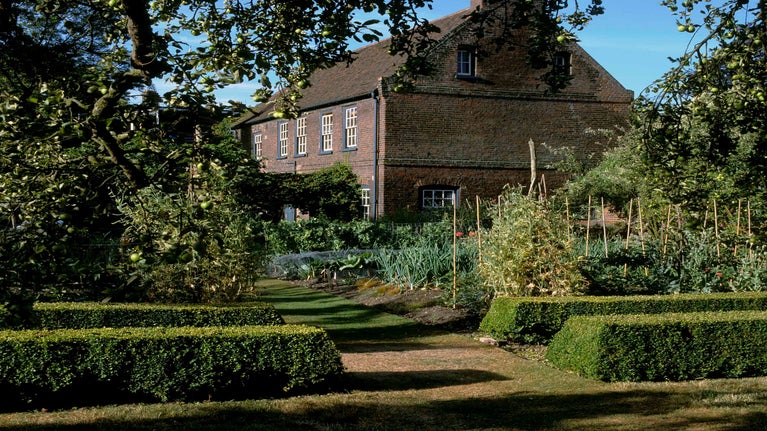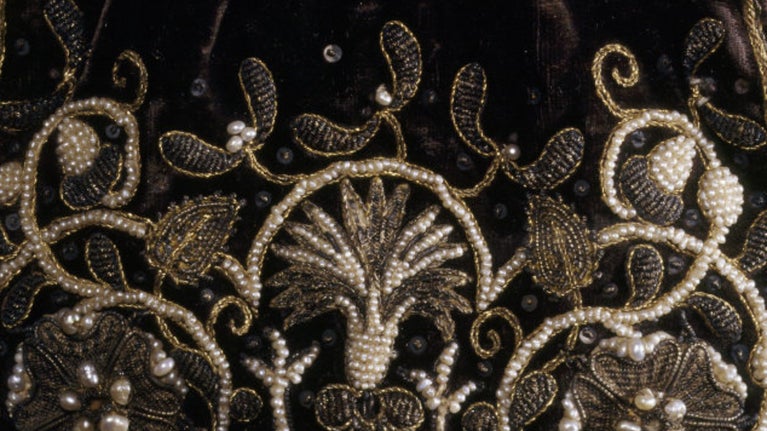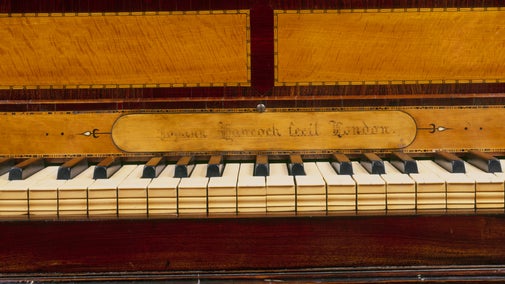
Fenton House and Garden's collections
Explore the objects and works of art we care for at Fenton House and Garden on the National Trust Collections website.

Fenton House is an art gallery on a domestic scale, offering quiet beauty and opportunities to look closely. The red brick house, with its garden and orchard, is the setting for objects and art of exceptional quality, assembled by discerning collectors. Delicate 17th-century needlework sits alongside rare Chinese cloisonné, 16th-century keyboard instruments and early 20th-century pictures by artists including Walter Sickert and Laura Knight.
In the 1680s, during the last years of James II’s reign, William Eades (?–1700) designed and built a house in Hampstead. It was a speculative investment which he intended to sell on completion. The square floor plan, with sash windows and a sweeping principal staircase, was typical of a late 17th-century gentry house on the outskirts of London.
By 1693, a lawyer, Sir George Hutchins (1640–1705), was in residence as the house’s first named tenant. Over the next 200 years, some 20 named owners and tenants lived at the house, known as Ostend House and the Clock House until at least 1860 when it is first recorded as Fenton House.
The house’s occupants were well-to-do and well-connected. There were lawyers; merchants trading in timber, textiles and tobacco; a former MP for Bristol who did business in the Caribbean; manufacturers; a justice of the peace; and the Chief Engineer of the Gas, Light and Coke Company. There were also sole women owners and occupiers, including Lady Binning, who gave the house to the National Trust.
From the outside, the house appears largely unaltered from its 1680s plan by its succession of owners. But most were wealthy enough from their professional lives to make changes. The golden gates include the cipher of Joshua (1667–1730) and Anna Gee (?–1730), who lived at the house from 1706–30. James Fenton (in residence 1796–1834) added a Neo-classical loggia.
Inside the house, James Fenton moved internal walls and probably stripped out the 17th-century decorative panelling. It was Sir Richard Hart Davis (1766–1842, in residence 1834–41) who introduced a marble chimney piece on the first floor. G. C. Trewby (c.1839–1910), the gas engineer (in residence 1884–1910), added an extension for bathrooms and converted the coach house, previously the stables, into a motor garage.

It was the Gees, in the early 1700s, who created the extensive walled garden which survives today. Joshua Gee was a Quaker with trade connections to the Americas and William Penn, founder of the Province of Pennsylvania in North America. The Gees created raised walks along the walls of the pleasure garden. When the house was sold in 1756, it was advertised with fruit-trees and a kitchen-garden, both of which were revived by the National Trust in the 1980s.
In 1936, Katherine, Lady Binning (1871–1952) bought the house. She planned to turn it into a permanent display space for her collections. She approached the National Trust, and following years of negotiation, the Trust opened Fenton as a museum-gallery in 1952. The Trust displayed Lady Binning’s collections in situ, alongside Major George Benton Fletcher's (1866–1944) playing collection of early keyboard instruments. In 2006, the National Trust added a third major collection of 19th and 20th century paintings donated by the actor, Peter Barkworth (1929–2006).

Katherine, Lady Binning, was the niece of George Salting (1835–1909). Salting inherited a large fortune made on the sheep and sugar farms of Australia. He dedicated it to the acquisition of a remarkable collection, much of which he left to the V&A, British Museum and National Gallery. Katherine’s mother, Millicent Salting (c.1848–1924), was also a collector of pottery, porcelain and needlework. Katherine’s own collecting interests reflected those of her uncle and mother.
Katherine inherited parts of her uncle’s and mother’s collections, though exactly which parts is sometimes unclear. The provenance of a rare cloisonné box, made in 15th-century China, is uncertain. She certainly bought some of the fine early Meissen figures for display next to high-quality English porcelain. Highlights of her needlework collection include an embroidered casket, worked by a young girl in the 17th century.

In the 1930s, you could buy a 16th-century virginals (a type of harpsichord) for next to nothing. Most owners had moved historic keyboard instruments out of the house to make way for a piano. Major George Benton Fletcher (1866–1944) was different. He believed that music should be played on the instruments for which it was written. He set out to assemble a collection and 'revive the neglected art of harpsichord playing’. His first purchase was a harpsichord in a second-hand shop. He found an 18th-century spinet (also a type of harpsichord) in a Welsh outhouse and rescued a virginals which was being used as a carpenter’s workbench.
Benton Fletcher’s enthusiasm for preservation brought him into contact with National Trust founders, Octavia Hill and Robert Hunter. After the 1937 National Trust Act, he transferred his collection, his house and a large endowment to the Trust. When his house was bombed in 1941, the Trust moved the instruments, first to Chelsea and then, from 1952, to Fenton House. Fenton was seen as a suitable setting for the instruments, which form one of the finest playing collections in the UK.
The most recent addition to Fenton House is Peter Barkworth's picture collection, bequeathed in 2006. At 17, Barkworth (1929–2006) moved to London to train at the Royal Academy of Dramatic Art (RADA) with only £2 15s a week to live on (his father having given up tobacco and alcohol to provide).
Barkworth visited Hampstead on his first weekend in London and moved to Flask Walk, off the High Street, in 1962. He began to build a collection of pictures, some of them painted in and around Hampstead. In 1980, Barkworth bought a painting by John Constable, Cumulus Clouds over a Landscape. He imagined the artist ‘going the few yards to the top of the hill from his house at 2 Lower Terrace [in Hampstead], and looking north at the small hills and the sky’. He gave this Constable to Fenton House, along with more than 50 other pictures.
Barkworth worked with Fenton’s curator to select paintings which suited the quiet setting of the house. They chose artists associated with the Camden Town Group, such as Walter Sickert and Duncan Grant. They also selected works by the women who were not allowed to be Group members, including Sylvia Gosse, Ethel Walker and Laura Knight. Theatrical scenes, including Clare Atwood’s The Rehearsal and Spencer Gore’s The Britannia Ballet, connect the collection to Barkworth's long career in acting.
For centuries, Fenton House has been a tranquil space in a busy city. In the 1680s, William Eades created roof terraces at the house to provide panoramic views of London. The view has changed since then, and since Charles Ginner painted Pond Street in the early 20th century, but not much.
Like many London houses, Fenton has seen tenants come and go. The National Trust, which has opened the house to the public since 1952, has brought together decorative arts, pictures and musical instruments from across the centuries and restored the garden, creating chance harmonies and connections inside and out.

Explore the objects and works of art we care for at Fenton House and Garden on the National Trust Collections website.
Explore Fenton House, one of London’s hidden treasures, a 17th-century house with vibrant ceramics, early keyboard instruments and intricate needlework.

Step back in time as you listen to historic instruments being played by our musicians, with the oldest dating back to 1540. Find out more about this unusual collection when you visit Fenton House.
